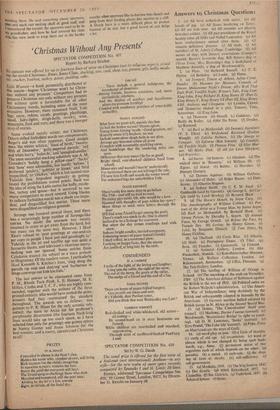Answers to Christmas Questions
I. (a) All have cathedrals with spires. (b) All breeds of pig. (c) All States bordering on Texas. fin All are iron ores. (e) All counties not playing first-class cricket. (f) All past-presidents of the Royal Society (also all OMs and Nobel Laureates). (g) All have confectionery named after them. (J) All vitamin deficiency diseases. (i) All birds, ID All members of St. John's College. Cambridge. (k) All names of dogs with literary associations (Cowper's spaniel, Byron's favourite dog, Bill • Sykes's dog in Oliver Twist, Mrs. Browning's dog, a dachshund of Matthew Arnold's, a dog of Wordsworth's).
2. (a) Plato. (h) Bertrand Russell. (c) T. E. Hulme. (d) Berkeley. (e) Locke. (f) Hume. 3. (a) Tempest, Timon of Athens, Julius Omar, Hamlet. (h) Measure for Measure,. Comedy of Errors, Midsummer Night's Dream, All's Well That Ends. Well, Twelfth Night, Winter's Tale, King Lear, King John, King Richard II, King Henry IV (Part 1), King Henry V, King Henry VI (Partly King Henry VIII, Anthony and Cleopatra. (e) Lavinia., Chiron and Demetrius (baked in a pie), Tamora, Titus, Saturninus. (d) King John.
4. (a) Thomson. (b) Morelli (c) Guldcner. (d) Bailly du Rollet. (e) Abbd Da Ponte. (f) Dryden. (g) Burnand.
5. (a) Back to Methuselah. (b) Sweeney Agonistes (T. S. Eliot). (c) Brides-head Revisited (Evelyn Waugh). (d) Zuleika Dobson. (e) She Stoops to Conquer. (j) Epiccene (Ben Jonson). (g) Candide.
(h) Twelfth Night. 11) Pltineas Finn. (1) Silas Mar- ner. (k) Moby Dick. (1) All for Love (Dryden). (in) Warerley.
6. fa) Icarus. (b4 Samson. (c) Absalom. (d) The wicked sister in 'Binnorie.' (e) William III. • (f) /Egeus. (g) Marat. (h) Baldur. (i) Hercules. (I) Humpty Dumpty.
7. (a) Thomas Aquinas, (h) William Ockham.
(c) Alexander of Hales. (d) Roger Bacon. (e) Duns Scotus. (f) Albertus Magnus.
8, (a) Sydney Smith. (b) C. E. M. Joad: (c) Goldsmith (said by Garrick): (d) George I. (e) Car- lyle (said by Lord Morley). (f) Bernard Shaw.
9. (a) The Horse's Mouth, by Joyce Cary. (b) The Autobiography of William Cobbett. (e)
Por-
trait of the Artist as a Young Man, by James Joyce.
(d) Back to Methuselah, by Bernard' Shaw. (e) Strong Poison, by Dorothy L. Sayers. (/) Animal Farm, by George Orwell. (g) Before the Fact, by Francis Iles. (h) Loving, by Henry Green. (1) Sybil, by Benjamin Disraeli. (1) Tom Jones, by Henry Fielding.
10. (a) Thailand. (h) Costa Rica. (c) Albania. (d) Haiti. (e) Portuguese Timor. (f) Tibet, (g) Peru. (h) Ecuador. (i) Guatemala. (j) Finland. 11 (a) National Gallery, London. (b) Alte Pinakothek, Munich. (c) Kunsthistorisches Museum, Vienna. (d) Wallace Collection. London. (e) Rijksmuseum, Amsterdam. (f) Uffizi, Florence. (g) The Tate Gallery, London, 12. (a) The landing of William of Orange in Ireland. (h) The marching of the mob on Versailles, (c) The American defence of Baltimore against the British in the war of 1812. (d) Political satire on Sir Robert Walpole's administration. (e) The Ameri- can War of Independence; sung derisively by the British and subsequently adopted in bravado by the Americans. (f) German wartime ballad adopted by British troops in N. Africa in the Second World War.
13. (a) Donne, 'The Canonisation' (hold your tongue). (h) Marlowe, Doctor Faustus (correct). (c) Wordsworth, 'Westminster Bridge' (a sight so touch- ing). (d) D. H. Lawrence, 'Snake' (correct). (e) Ezra Pound, 'The Lake Isle' (correct). (f) Pope, Essay on Man (vindicate the ways of God).
14. (a) word-play or pun. (b) a form of insanity. (c) study of old age. (d) recantation. (e) word or phrase which is not changed by being spelt back- wards, e.g., Anna. (f) permanent union of two organisms each of which depends on the other. (g) paradox. (h) a metal. (i) mob-rule. (j) the shap- ing of trees • or shrubs. (k) self-sufficiency. (1) self-governmeht.
15. (a) Moshulu, 1939. (b) The brig Somers, 1842. (c) Dei Gratia. (d) HMS Birkenhead,. 1852. (e) Carpathia. (I) Sao Gabrielc. (g) Vaderland. 1897. (h) Admiral Scheer. (1) Sirius.


































 Previous page
Previous page